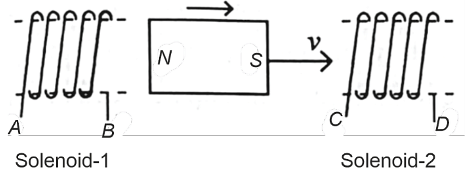
In the above diagram, a strong bar magnet is moving towards solenoid-2 from solenoid-1. The direction of induced current in solenoid-1 and that in solenoid-2, respectively, are through the directions :

In the above diagram, a strong bar magnet is moving towards solenoid-2 from solenoid-1. The direction of induced current in solenoid-1 and that in solenoid-2, respectively, are through the directions :
- AB and DC
- BA and CD
- AB and CD
- BA and DC
The Correct Option is A
Approach Solution - 1
When a strong bar magnet moves towards a solenoid, it induces an electromotive force (EMF) in the solenoid due to electromagnetic induction. The direction of the induced current can be determined using Lenz's Law, which states that the direction of the induced current is always such that it opposes the change in magnetic flux that produced it. Let's analyze the problem step by step:
- As the bar magnet approaches solenoid-1, the magnetic flux linked with solenoid-1 increases. To oppose this increase, the induced current in solenoid-1 will flow in such a direction that its own magnetic field opposes the field of the approaching magnet.
- Using the right-hand rule, if the north pole of the bar magnet is moving towards solenoid-1, the induced current in solenoid-1 will flow in direction AB. This creates an induced magnetic field with its north pole facing the approaching bar magnet.
- Now, consider solenoid-2. As the bar magnet moves away from solenoid-1 and approaches solenoid-2, it causes an increase in magnetic flux linking solenoid-2. Hence, the induced current in solenoid-2 will flow in such a direction that its magnetic field opposes the new incoming magnetic field.
- Using Lenz's Law again, if we apply the right-hand rule to solenoid-2, the induced current in solenoid-2 will flow in direction DC, creating an induced magnetic field with its south pole facing the bar magnet.
Therefore, the correct option is AB and DC, where the induced current in solenoid-1 flows in direction AB and in solenoid-2 flows in direction DC respectively.
Approach Solution -2

Step 1: Use Lenz’s Law
According to Lenz’s law, the induced current always flows in a direction such that it opposes the change in magnetic flux that causes it.
Step 2: Analyze Solenoid-1
As the bar magnet approaches solenoid-1, the magnetic flux increases. To oppose this increase, solenoid-1 generates a magnetic field opposite to the bar magnet’s field, inducing a current in the direction AB.
Step 3: Analyze Solenoid-2
For solenoid-2, the magnetic field due to the approaching bar magnet increases in the direction towards solenoid-1. To oppose this, solenoid-2 generates a magnetic field pointing away, inducing a current in the direction DC.
Top Questions on Solenoids and Toroids
- The self-inductance of a solenoid depends on
- Bihar Board XII - 2025
- Physics
- Solenoids and Toroids
- The direction of magnetic field inside a current carrying solenoid is
- Bihar Board XII - 2025
- Physics
- Solenoids and Toroids
- The magnitude of magnetic field inside a solenoid of length 0.3 m having 800 turns carrying a current of 6 A is
- CUET (UG) - 2025
- Physics
- Solenoids and Toroids
- (i) State any two factors on which the strength of magnetic field produced by a current-carrying solenoid depends.
- UP Board X - 2025
- Science
- Solenoids and Toroids
- (i) Draw magnetic lines of force due to a current carrying solenoid.
- UP Board X - 2025
- Science
- Solenoids and Toroids
Questions Asked in NEET exam
- A balloon is made of a material of surface tension S and has a small outlet. It is filled with air of density \( \rho \). Initially the balloon is a sphere of radius R. When the gas is allowed to flow out slowly at a constant rate, its radius shrinks as \( r(t) \). Assume that the pressure inside the balloon is \( P(r) \) and is more than the outside pressure (\( P_0 \)) by an amount proportional to the surface tension and inversely proportional to the radius. The balloon bursts when its radius reaches \( r_0 \). Then the speed of gas coming out of the balloon at \( r = R \) is :
- NEET (UG) - 2025
- Surface Tension
- Two identical point masses P and Q, suspended from two separate massless springs of spring constants \(k_1\) and \(k_2\), respectively, oscillate vertically. If their maximum velocities are the same, the ratio of the amplitude of P to the amplitude of Q is :
- NEET (UG) - 2025
- Waves and Oscillations
A sphere of radius R is cut from a larger solid sphere of radius 2R as shown in the figure. The ratio of the moment of inertia of the smaller sphere to that of the rest part of the sphere about the Y-axis is :

- NEET (UG) - 2025
- Moment Of Inertia
- A microscope has an objective of focal length \(f_o = 2\) cm and an eyepiece of focal length \(f_e = 4\) cm. The tube length of the microscope is \(L = 40\) cm. If the distance of distinct vision of eye is \(D = 25\) cm, the magnification in the microscope is:
- NEET (UG) - 2025
- Optical Instruments
AB is a part of an electrical circuit (see figure). The potential difference \(V_A - V_B\), at the instant when current \(i = 2\) A and is increasing at a rate of 1 amp/second is:

- NEET (UG) - 2025
- Electromagnetic Induction and Inductance